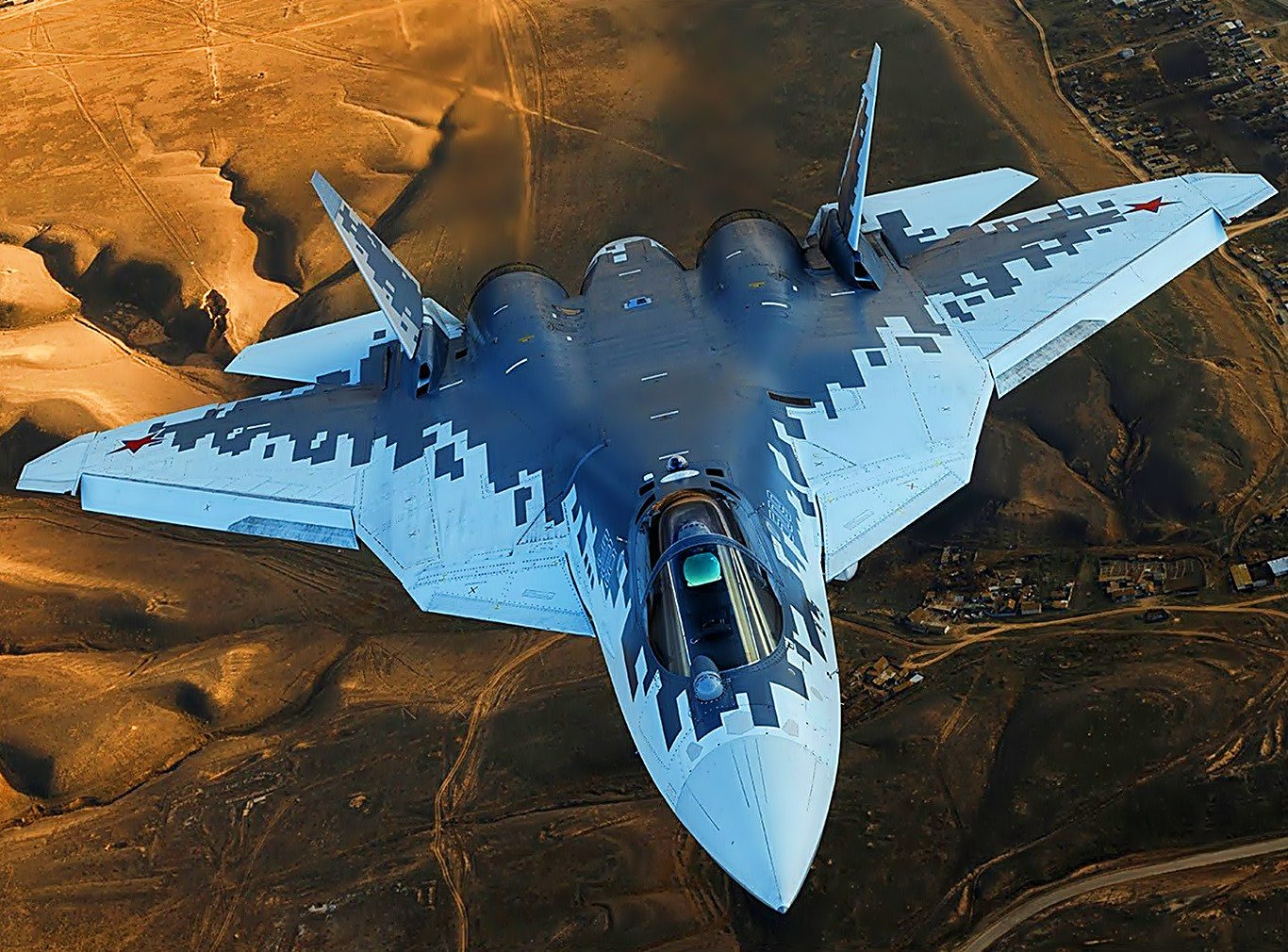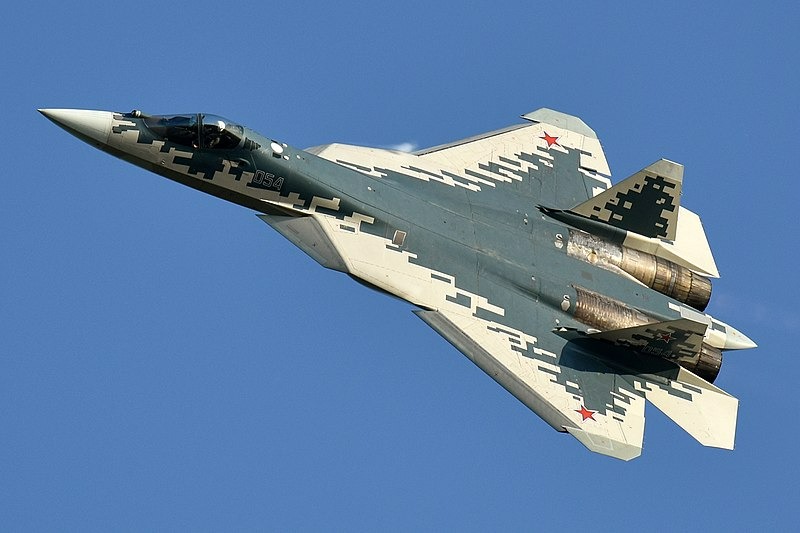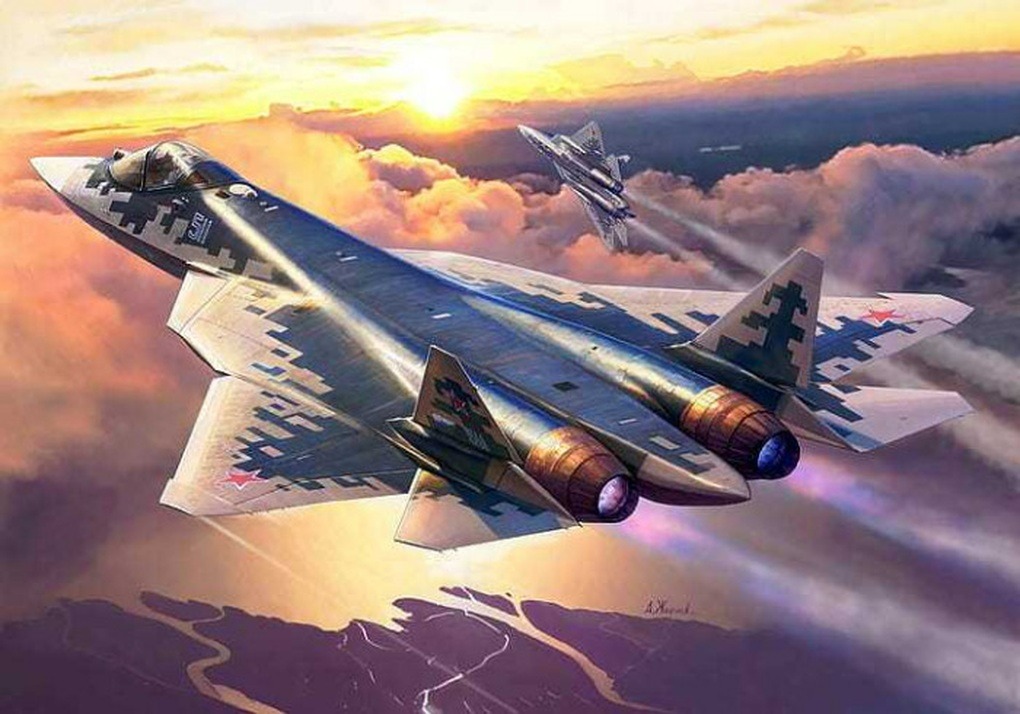The Su-57 is a multi-role fighter designed to overcome enemy air defense systems and destroy all types of targets on the ground and at sea.

“Sky Ghost” Su-57 – the best military aircraft in the world
The fifth-generation fighter, the Sukhoi Su-57 (also known as PAK FA, or T-50) is a single-seat, twin-engine, multirole stealth jet fighter, developed since 2002 to overcome enemy air defense systems, destroy all types of long- and short-range air targets, and attack ground and naval targets.
In June 2019, the Russian Ministry of Defense and Sukhoi Company signed a contract, according to which the first 76 Su-57 aircraft will be completed by 2027, expected to equip 3 regiments deployed in 3 strategic regions of Russia located in the northwest, southwest and Far East.
With aircraft currently in service such as the MiG-31BSM and Su-35, Russia is fully capable of dealing with the most modern American fighter jets such as the F-22 Raptor and F-35 Lightning II. The Su-57 was built by Russia to counter the aircraft being developed by the US for the future – the sixth generation fighter of the US Air Force, which is much more powerful than the F-22.
The experimental Su-57 model uses the Izdeliye-117 jet engine, the mass-production version of the Su-57 uses the Izdeliye-30 jet engine, providing 30% more thrust, allowing the aircraft to operate at altitudes of up to more than 21 km above sea level.
The Su-57 is 19.8m long, has a wingspan of 13.95m, a height of 4.74m, an empty weight of 18 tons, a maximum take-off weight of 35 tons, a fuel load of 10.3 tons, and a weapons load of 8 tons; can reach a maximum speed of Mach 2, supercruise at Mach 1.6, a maximum supersonic range of 1,500km and 4,500km when carrying maximum internal and external fuel; a service ceiling of 20km.
Similar to the F-22, the Su-57 fuselage integrates a number of special sensors, allowing it to detect and warn of enemy missile attacks. But more than the F-22, both the upper and lower fuselages of the Su-57 are equipped with laser devices capable of blinding the guidance heads of infrared-guided missiles from both the air and the ground, in line with the criteria of multi-role defense and attack – including high super-maneuverability, more limited stealth compared to the F-35 and F-22, but equipped with modern electronic warfare technologies, allowing the aircraft to avoid attacks by long-range air-to-air missiles, engage in combat within the limits of long-range visibility or close combat. This capability has not been achieved by any fighter aircraft in the first prototype design, including the F-35.
Su-57 weapons

The Su-57 is capable of carrying a large payload of 14 types of “air-to-air” and “air-to-ground” weapons, including 10 air-to-air missiles – the most advanced new models such as the R-37M hypersonic long-range missile (speed over Mach 5, created to equip the MiG-31BM and Su-57 interceptors) and the K-77.
Compared to the original, the R-37M has been updated with many new features and technologies, notably the guidance system, operating in two modes, active (automatically switching to another more important target with support from the launch aircraft’s radar via the data link channel) and semi-active (the enemy aircraft does not know that it is being attacked).
The K-77 belongs to the R-77 medium-range missile line but has surpassed the threshold and become a long-range missile, capable of attacking airborne targets about 192km away, 1.75 times the old range of the R-77, speed 4.5M, interception ceiling from 20m – 25km.
CAB-250 bomb – “smart bomb”, designed specifically for Su-57 has a memory containing images of the target to be attacked, with most of the flight path under the control of the inertial guidance system and the ability to adjust by satellite positioning signals; at the end, the head guides itself by image (during the day) and by thermal sensors (during the night).
The missiles that attack land and surface targets are anti-radar missiles equipped with passive radar homing heads Kh-58UshKE (TP) with a range of 250km. The broadband target homing head counters the enemy’s radar homing system by continuously switching frequencies, which can knock out the enemy’s radar homing system even in the event of an emergency power outage.
Among the “air-to-surface” missiles created for the Su-57, there is the Kh-38M multi-purpose short-range missile (up to 40km). One of the advantages of the Kh-38M is that it can be equipped with various types of self-guided heads and warheads according to combat missions – destroying enemy manpower, infantry equipment, fortified structures, and surface warships.
The Kh-31 long-range air-to-surface missile has two variants, including the Kh-31P anti-radar missile with a range of 250km and the Kh-31A anti-ship missile with a range of 150km, which are also integrated into the Su-57. Almost all of the high-precision munitions listed above have been tested in Syria on the Su-57.
In the future, the Su 57 will be equipped with the KS-172 long-range missile with a range of 400 km – a world record for the range of an “air-to-air” missile; at the same time, according to the Russian State Armaments Program for 2018-2027, the Su 57 will be equipped with hypersonic missiles with characteristics similar to the “invincible” Kinzhal missile that cannot be detected by current air defense systems.
A new pilot rescue system has been developed specifically for the Su-57, including an ejection seat and an anti-overload flight suit. In addition, the testing of the communications system is being completed, the structure and operation of which are significantly different from before; advanced high-speed data transmission technology and new network solutions have been applied.
The aircraft is equipped with the most powerful electronic systems ever such as Byela radar (400km reconnaissance range, tracking 60 targets at the same time); L402 Himalayas electronic warfare system; 101KS Atoll optical reconnaissance system, the most advanced radar technology in the world today – AESA active electronically scanned array, capable of automatically assessing situations on the battlefield, can detect threats in the air, on the ground and at sea, especially enemy stealth fighters, from a distance far beyond any modern radar system.
The Su-57 itself is also very difficult to detect on radar systems because it is covered with a special wave-absorbing paint. The Su-57’s guided and unguided weapons are hidden in internal compartments of the aircraft to minimize detection by radar.
Compared to previous generations, the Su-57 combines the functions of an attack aircraft and an interceptor, using many composite materials, applying advanced technologies and aerodynamic structures to ensure less radar and infrared reflection, giving the Su-57 superiority over its opponents… which the Russian President rated as the best military aircraft in the world. With new generation attack weapons, the Su-57 will be able to suppress enemy air defenses and attack extremely powerful air and ground targets, contributing to enhancing the combat capabilities of the Russian Air Force – Space Forces.
Tested on the battlefield in Syria

According to the Russian Air Force and Space Force, the first batch of Su-57s consisted of 12 aircraft, four of which were deployed in Syria and in late 2018 alone, carried out more than 10 flights to test the capabilities of weapons and equipment systems as well as artificial intelligence in various harsh conditions.
The deployment marks the simultaneous appearance of three of the world’s most powerful fighters in the region – the Su-57, the F-22 (US Air Force) and the F-35 (Israeli Air Force). Artificial intelligence simplifies the control of fighter jets, significantly expanding the combat capabilities and super-maneuverability of the Su-57 in unmanned mode. The use of the Su-57 prototype in Syria is Russia’s way of declaring that the fighter is ready for combat.
The most prominent image of the Su-57 when present in Syria was the test launch of the Kh-59MK2 long-range air-to-surface cruise missile (designed to fit into the weapon bay) to attack fixed enemy targets beyond the line of sight from outside the protection range of air defense systems. This is where Russia is considered to be ahead of the US, because the F-22 and F-35 still have to conduct airstrikes using the GBU-39 SDB small diameter bomb.
However, the Su-57 was also criticized for revealing its weaknesses when its stealth paint could not withstand the harsh climate in Syria – the main reason why Russia had to quickly bring the Su-57 back home, because the field conditions in Syria did not have enough logistical facilities to ensure the technical support for this high-tech paint.
According to Izvestia, the Su-57’s radio-electronic equipment has passed testing in Syria, giving it an edge over its rivals. Despite only deploying the Su-57 to Syria for a short time, Russia has still collected a lot of important data to detect potential weaknesses in the design, thereby applying the necessary changes to increase the power, as well as increase the attractiveness of the Su-57 in the export market.
According to IHS Janes, the export variant of the Su-57, the Su-57E, has received approval for export from the Russian president and will officially appear at the Dubai Air Show in November 2019. South Korea, India, Brazil, China, several Gulf countries and Türkiye… have expressed interest in this fighter./.





